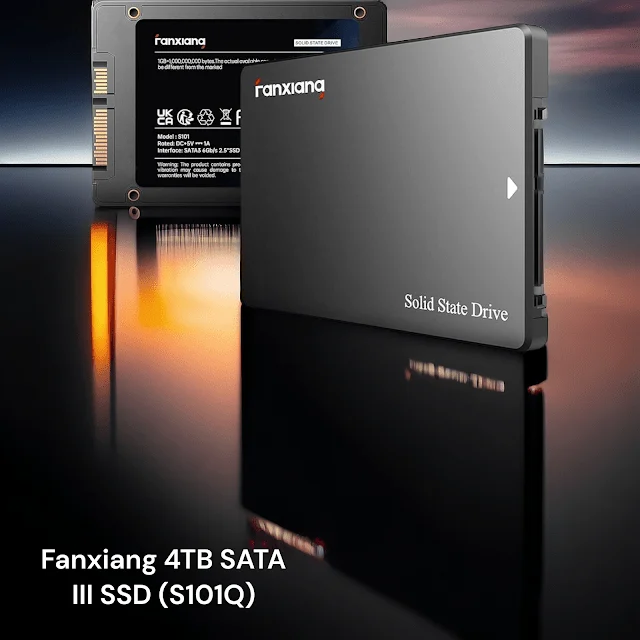
✅ How SSDs Work: NAND Flash, Cache, and Controllers
✅ Why SSD Performance Slows Down During Large Transfers
✅ Why SSDs Overheat & How to Prevent It
✅ Why DRAM-Less SSDs Are Slower for Certain Tasks
✅ Common Mistakes to Avoid for Better Performance
✅ Best Practices for Maximizing SSD Lifespan
📊 Fanxiang M.2 2TB SSD: Key Specifications
Before diving into performance insights, here’s a breakdown of its core specifications:
- Interface: PCIe Gen3x4 NVMe
- Capacity: 2TB
- Read Speed: Up to 3,500MB/s
- Write Speed: Up to 3,000MB/s
- Memory Type: 3D NAND TLC
- Cache: DRAM-less (uses HMB – Host Memory Buffer)
- Form Factor: M.2 2280
🔬 How SSDs Work: NAND Flash & Cache Explained
To understand SSD performance, it’s essential to know how data is stored and managed.
1️⃣ NAND Flash Types
SSDs use NAND flash memory, which comes in different types:
✔ SLC (Single-Level Cell): Fastest, longest lifespan, but expensive.
✔ MLC (Multi-Level Cell): Balances speed and durability.
✔ TLC (Triple-Level Cell): Used in most consumer SSDs, including Fanxiang M.2—good for general use.
✔ QLC (Quad-Level Cell): Cheapest, but slowest and less durable.
2️⃣ SLC Cache: Why Large File Transfers Slow Down
🔹 How It Works: Budget SSDs like the Fanxiang M.2 use SLC caching to speed up write operations temporarily. Small files benefit from high speeds due to this cache.
🔹 Why Speed Drops on Large Files: When the SLC cache is full, the SSD writes directly to TLC NAND, which is significantly slower. This is why short transfers are fast, but large transfers (50GB+) slow down.
💡 How to Avoid Slowdowns:
✔ Choose an SSD with DRAM cache for sustained high-speed transfers.
✔ Keep 10-20% of the SSD space free to improve data management.
🔥 Why SSDs Overheat & How to Prevent It
SSDs generate heat when handling heavy workloads, and while the Fanxiang M.2 includes a thermal sticker, it may not be sufficient for intense tasks.
🔻 What Causes SSD Overheating?
- Sustained large file transfers stress the NAND chips and controller.
- Poor airflow in a PC or laptop traps heat.
- Basic thermal solutions (stickers) do not dissipate heat effectively.
🔻 Effects of Overheating:
- Thermal throttling: The SSD slows down automatically to prevent damage.
- Performance drop: Read/write speeds can decrease significantly (e.g., from 3,500MB/s to 1,500MB/s).
- Reduced lifespan: Prolonged heat exposure degrades NAND memory faster.
💡 Prevent Overheating:
✔ Install an M.2 heatsink for improved cooling.
✔ Ensure good airflow in your PC case or laptop.
✔ Avoid continuous large file transfers without breaks.
⚠️ Why DRAM-Less SSDs Are Slower for Certain Tasks
The Fanxiang M.2 SSD lacks a DRAM cache, relying instead on HMB (Host Memory Buffer), which uses system RAM to manage data.
🔴 Why is This a Problem?
- DRAM speeds up data access by storing the SSD’s file map.
- Without DRAM, random read/write speeds suffer, making boot times and app launches slower.
💡 Who Should Avoid DRAM-Less SSDs?
✔ Power users & professionals: Consider a DRAM-equipped SSD like the Samsung 970 EVO Plus.
✔ Casual users & gamers: A DRAM-less SSD is sufficient for storing games and files.
🆚 Market Comparison: How Fanxiang SSD Stacks Up
💰 Best Budget PCIe 3.0 SSD: Fanxiang M.2 2TB ✅.
🔥 Best for High-End Workloads: Samsung 970 EVO Plus 🔥.
🎮 Best for Gaming: WD Black SN750 🎮.
🛠️ Best Practices for SSD Longevity
💡 1. Enable TRIM Command
✔ Optimizes SSD performance over time.
💡 2. Keep Firmware Updated
✔ Check Fanxiang’s website for the latest firmware updates.
💡 3. Use Proper Cooling
✔ If using for intensive gaming or video editing, install a heatsink.
💡 4. Avoid Writing Large Files Continuously
✔ Prevents SLC cache exhaustion and ensures stable speeds.
💡 5. Leave Free Space on the SSD
✔ Keeping at least 10-20% free space boosts performance & lifespan.
🏆 Final Verdict: Should You Buy the Fanxiang M.2 SSD?
✔ Best for: Budget users, gamers, general PC upgrades.
❌ Not for: Professional workloads, 4K video editing, sustained large transfers.
🔹 Buy If:
✔ You need an affordable PCIe 3.0 SSD with solid speeds.
✔ You want 2TB storage without spending too much.
🔹 Avoid If:
❌ You need top-tier endurance & DRAM cache for heavy tasks.
❌ You plan on using the SSD without extra cooling.
🚀 Conclusion: A Great Budget SSD with Clear Limitations
The Fanxiang M.2 2TB SSD is an excellent budget-friendly NVMe drive. However, users must understand its limitations—SLC cache exhaustion, heat issues, and lack of DRAM. If you follow best practices, this SSD can deliver great performance for everyday users.
💡 Final Verdict: If you need a budget PCIe 3.0 SSD, the Fanxiang M.2 2TB is a great option—but it’s not ideal for professional workloads. 🔥






